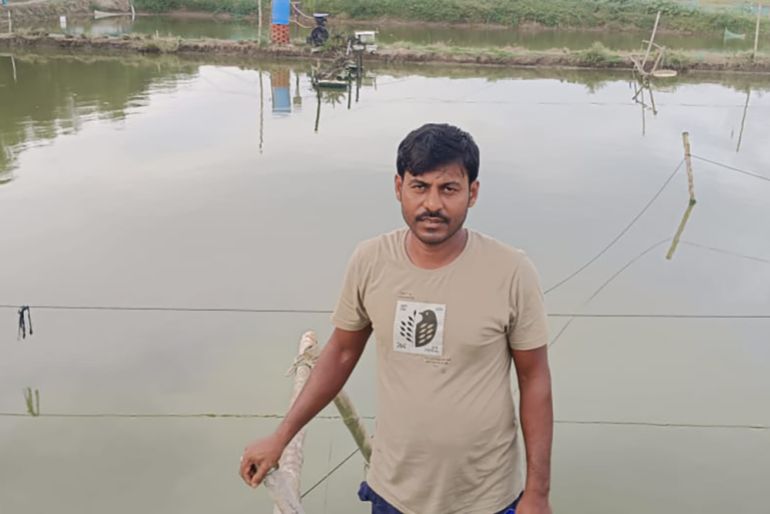Kolkata, India: Buddhadeb Pradhan, a shrimp farmer in Nandigram in the West Bengal state in eastern India, has taken a major risk by cultivating a second shrimp crop within weeks of harvesting the first cycle.
But he needs the money and is willing to risk a diseased crop, a common occurrence when there are two harvesting cycles in a pond in the same year.
He was partly pushed into making that decision because of the falling price of the shrimp on account of the tariffs imposed on India by United States President Donald Trump.
“The falling prices of the shrimp have me stressing if I can recover my investment of 300,000 rupees [$3,380],” he told Al Jazeera.
India is the world’s second-largest producer of shrimp – predominantly for export – after Ecuador. In the financial year ending in March 2025, it sent $5bn of frozen shrimp globally, with the US accounting for about 48 percent of its sales.
It produces two commercial varieties of marine and freshwater shrimp, black tiger and Pacific whiteleg, popularly known as vannamei (Litopenaeus vannamei).
India’s shrimp production stood at 1.1 million tonnes, predominantly vannamei, but also 5 percent black tiger, in the financial year ending March 2024, as per the latest data available.
India has two distinctive shrimp cycles of vannamei, starting from February to June and then from July to October. Farmers are generally reluctant to go for a second cycle, fearing diseases. The black tiger is a single crop from March to August.
The shrimp is cultivated in the coastal states of West Bengal, Gujarat, Odisha, Andhra Pradesh, Tamil Nadu, Goa, Maharashtra, Karnataka and Kerala. The industry employs approximately 10 million people, including the shrimp farmers and people at hatcheries, processing units, and others, said Manoj Sharma, a veteran shrimp farmer.
Since the tariffs were announced in May, farm prices of shrimp dropped from 300 rupees ($3.38) per kilogramme to 230 rupees ($2.59) as farmers tried to offload whatever they had. With production costs at 275 rupees ($3.10) per kilogramme, losses are mounting.
Nardu Das, 40, a shrimp farmer in Nandigram, told Al Jazeera that farmers might be forced to consume “poison” if the market doesn’t stabilise and prices do not increase.
The 40-year-old said shrimp farming is a costly affair with bills for power, lease on land, feed and other expenses.
“The farmers not only risk their savings but also take loans with the hope of massive returns. But diseases and the fall in prices often push them to the brink of poverty,” he said.
Farmers are worried that with tariffs at 58.26 percent – including countervailing duties of 5.77 percent and anti-dumping duties of 2.49 percent – they will lose their US market.
“The US is a preferred destination for shrimp exporters because of easy market access, higher growth prospects, better profit margins, and repeat customer approvals. The hike in tariffs will discourage farmers from continuing to invest in shrimp culture that also incurs upfront costs of land lease, seed and feed,” said Rahul Guha, senior director of Crisil Ratings.
India brings its brood stock – the term for the mother shrimp – in chartered flights from the US to breed to produce seeds for farming. But there have been cases where it is either of poor quality or unfit for the Indian environment, in turn leading to disease among the shrimp produce, which then has to be thrown away.
“We have been demanding the government to breed the shrimps using the local brood stock in order to get the high-quality seeds that adjust to our conditions,” said IPR Mohan Raju, president of the Prawn Farmers Federation of India.
Another spillover of the tariffs has been on hatcheries. India has about 550 private hatcheries that depend on these shrimp farmers for their livelihood.
Several farmers, fearing a further dip in prices of shrimp, have stopped buying seeds, and at least half the hatcheries have already shut down, said Ravid Kumar Yellanki, president of All India Shrimp Hatcheries Association.
“Undoubtedly, the US tariffs have begun to have a major impact on the hatcheries, with many halting production,” Yellanki said.
These hatcheries produce approximately 80 billion seeds annually and have drained seven to eight billion seeds in the past four months due to no demand from the farmers, as the shelf life of seeds is just three to four days.
“It would be a major loss to the hatchery owners if the situation doesn’t turn normal soon,” Yellanki added.

Ecuador, another headache
India is already facing stiff competition from Ecuador, which has been expanding its share of the US market due to its geographical proximity to the US.
Ecuador produces high-quality vannamei shrimp at a lower price, as that is its domestic species. Plus, tariffs on it are at 15 percent, much lower than India’s, making it a more attractive market for the US to source from.
During the first nine months of 2025, Ecuador exported 1,038,208 metric tonnes of shrimp to the US, up 14 percent year-on-year, with a total value of $5.51bn, representing a 23 percent increase compared with the same period last year.
Sharma, the aquaculture expert, says the US tariffs will force Indian exporters to compete among themselves to sell to alternate markets.
Source: Aljazeera

Leave a Reply